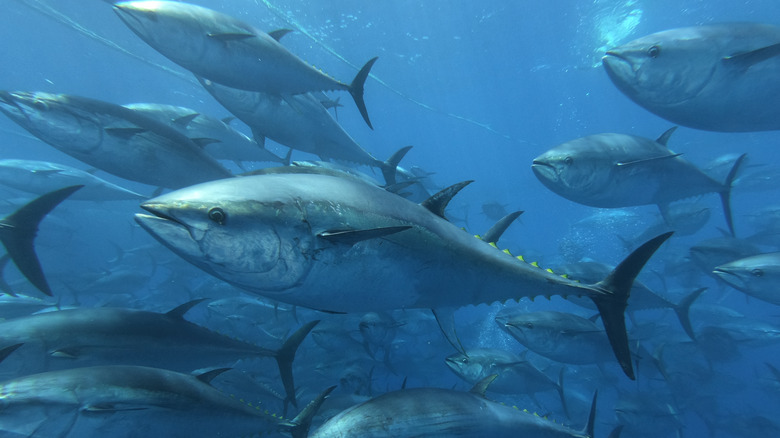White Tuna Vs. Light: What's The Difference?
Canned tuna is a special thing: It's an ingredient that is cheap, tasty, and something that has avoided the impact of trends and diets to remain consistently popular for decades. According to the National Fisheries Institute, canned tuna was the third most consumed seafood in the United States in 2020. While people obviously love a good tuna melt, tuna is also a healthy way to get a lot of protein in your meal, with Good Housekeeping noting that 3 ounces of canned tuna has 20 grams of protein, while also containing omega-3 fatty acids and other minerals. Add to that it's easy prep and versatility and it's no surprise why canned tuna has remained a staple for so long.
Like a lot of packaged ingredients at the supermarket, the variety within canned tuna can be a lot to take in, especially as more and more brands have appeared on shelves next to old stalwarts like Bumblebee and StarKist. Tuna comes in different textures and packed in different liquids like water or oil, both of which are going to affect the taste of your next tuna salad.
The most common of these labeling differences may also be one of the most confusing for buyers to parse: White tuna vs. light. So what sets these two varieties of canned tuna apart?
White tuna and light come from different species of tuna
White tuna and light tuna vary by coming from different species of tuna. According to Chicken of the Sea, white tuna is made from just one species, albacore, while light tuna can be made from yellowfin or skipjack, or even a mix of those two species. My Recipes states that albacore is generally the preferred tuna among American consumers, as it has a meatier texture and a more neutral, less fishy taste compared to the species used in light tuna. But of course the best tuna for you is down to personal taste and if you like a more powerful flavor, light tuna will be great.
Beyond taste, the differences between white and light tuna get smaller. Epicurious reports that albacore, skipjack, and yellowfin tuna all have a similar impact on the environment, with sustainability varying more by brand than by species. Nutritionally, the two styles are pretty identical, with only negligibly higher levels of mercury in white tuna. Both are okay to eat and their mercury levels are low enough that having multiple servings of canned tuna is advised (although it's best to limit intake for pregnant women and children).
Knowing all that, you can now focus on the fun stuff like what you are going to add to your tuna to make the tuna salad of your dreams.

